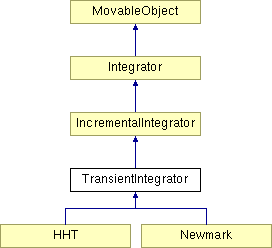Main Page Class Hierarchy Alphabetical List Compound List File List Compound Members File Members
TransientIntegrator Class Reference#include <TransientIntegrator.h>
Inheritance diagram for TransientIntegrator::
 List of all members.
List of all members.
Detailed Description
TransientIntegrator is an abstract subclass of IncrementalIntegrator. A subclass of it is used when performing a nonlinear transient analysis of the problem using a direct integration method. The TransientIntegrator class redefines the {formTangent()} method of the IncrementalIntegrator class and it defines a new method {newStep()} which is invoked by the DirectIntegrationAnalysis class at each new time step. \
In nonlinear transient finite element problems we seek a solution ( ,
,  ,
,  ) to the nonlinear vector function
) to the nonlinear vector function
\begin{equation} \R(U,Ud, Udd) = \P(t) - \F_I(Udd) - \F_R(U, Ud) = \zero \label{femGenForm} \end{equation}
The most widely used technique for solving the transient non-linear finite element equation, equation~\ref{femGenForm}, is to use an incremental direct integration scheme. In the incremental formulation, a solution to the equation is sought at successive time steps  apart.
apart.
\begin{equation} \R(U_{n \Delta t},Ud_{n \Delta t}, Udd_{n \Delta t}) = \P(n \Delta t) - \F_I(Udd_{n \Delta t}) - \F_R(U_{n \Delta t}, Ud_{n \Delta t}) \label{fullTimeForm} \end{equation}
For each time step, t, the integration schemes provide two operators,  and
and  , to relate the velocity and accelerations at the time step as a function of the displacement at the time step and the response at previous time steps:
, to relate the velocity and accelerations at the time step as a function of the displacement at the time step and the response at previous time steps:
\begin{equation} \dot U_{t} = {\I}_1 (U_t, U_{t-\Delta t}, \dot U_{t-\Delta t}, \ddot U_{t - \Delta t}, U_{t - 2\Delta t}, \dot U_{t - 2 \Delta t}. ..., ) \label{I1} \end{equation}
\begin{equation} \ddot U_{t} = {\I}_2 (U_t, U_{t-\Delta t}, \dot U_{t-\Delta t}, \ddot U_{t - \Delta t}, U_{t - 2\Delta t}, \dot U_{t - 2 \Delta t}. ..., ) \label{I2} \end{equation}
These allow us to rewrite equation~\ref{fullTimeForm}, in terms of a single response quantity, typically the displacement:
\begin{equation} \R(U_t) = \P(t) - \F_I(Udd_t) - \F_R(U_t, Ud_t) \label{genForm} \end{equation}
The solution of this equation is typically obtained using an iterative procedure, i.e. making an initial prediction for  , denoted
, denoted  a sequence of approximations
a sequence of approximations  ,
,  is obtained which converges (we hope) to the solution
is obtained which converges (we hope) to the solution  . The most frequently used iterative schemes, such as Newton-Raphson, modified Newton, and quasi Newton schemes, are based on a Taylor expansion of equation~\ref{genForm} about
. The most frequently used iterative schemes, such as Newton-Raphson, modified Newton, and quasi Newton schemes, are based on a Taylor expansion of equation~\ref{genForm} about  :
:
\begin{equation} \R(U_{t}) = \R(U_{t}^{(i)}) + \left[ {\frac{ -
tial \R}{\partial U_t} \vert}_{U_{t}^{(i)}}\right]
-
\left( U_{t} - U_{t}^{(i)} \right) \end{equation}
 \R(U_{t}) = \P (t)
\R(U_{t}) = \P (t)
- \f_{I} \left( \ddot U_{t}^{(i)} \right) - \f_{R} \left( \dot U_{t}^{(i)}, U_{t}^{(i)} \right)
 \begin{equation}
\begin{equation}
\left[ \M^{(i)} {\I}_2' + \C^{(i)} {\I}_1' + K^{(i)} \right] \left( U_{t} - U_{t}^{(i)} \right) \label{femGenFormTaylor} \end{equation}
To start the iteration scheme, trial values for  ,
,  and
and  are required. These are obtained by assuming
are required. These are obtained by assuming  . The
. The  and
and  can then be obtained from the operators for the integration scheme. \
can then be obtained from the operators for the integration scheme. \
Subclasses of TransientIntegrators provide methods informing the FE\_Element and DOF\_Group objects how to build the tangent and residual matrices and vectors. They also provide the method for updating the response quantities at the DOFs with appropriate values; these values being some function of the solution to the linear system of equations. \
}
Definition at line 150 of file TransientIntegrator.h.
Constructor & Destructor Documentation
|
TransientIntegrator::TransientIntegrator (
|
int classTag )
|
|
|
TransientIntegrator::~TransientIntegrator (
|
) [virtual]
|
|
Member Function Documentation
|
int TransientIntegrator::formEleResidual (
|
FE_Element * theEle ) [virtual]
|
|
|
|
Called upon by the FE\_Element {theEle} to determine it's contribution to the rhs of the equation. The following are invoked before  is returned. \begin{tabbing} while \= \+ while \= while \= \kill theEle-
is returned. \begin{tabbing} while \= \+ while \= while \= \kill theEle- zeroResidual()
zeroResidual()
Reimplemented from IncrementalIntegrator.
Reimplemented in HHT, and Newmark.
Definition at line 107 of file TransientIntegrator.cpp. |
|
int TransientIntegrator::formNodUnbalance (
|
DOF_Group * theDof ) [virtual]
|
|
|
|
Called upon by the DOF\_Group {theDof} to determine it's contribution to the rhs of the equation. The following are invoked before  is returned. \begin{tabbing} while \= \+ while \= while \= \kill theDof-
is returned. \begin{tabbing} while \= \+ while \= while \= \kill theDof- zeroUnbalance()
zeroUnbalance()
Reimplemented from IncrementalIntegrator.
Reimplemented in HHT, and Newmark.
Definition at line 115 of file TransientIntegrator.cpp. |
|
int TransientIntegrator::formTangent (
|
int statFlag ) [virtual]
|
|
|
|
Invoked to form the structure tangent matrix. The method is rewritten for this class to include inertia effects from the nodes. The method iterates over both the FE\_Elements and DOF\_Groups invoking methods to form their contributions to the  matrix of the LinearSOE and then adding these contributions to the
matrix of the LinearSOE and then adding these contributions to the  matrix. The method performs the following: \begin{tabbing} while \= \+ while \= while \= \kill theSysOfEqn.zeroA();
matrix. The method performs the following: \begin{tabbing} while \= \+ while \= while \= \kill theSysOfEqn.zeroA();
Reimplemented from IncrementalIntegrator.
Definition at line 61 of file TransientIntegrator.cpp. |
|
int TransientIntegrator::initialize (
|
void ) [inline, virtual]
|
|
|
int TransientIntegrator::newStep (
|
double deltaT ) [pure virtual]
|
|
The documentation for this class was generated from the following files:
|



